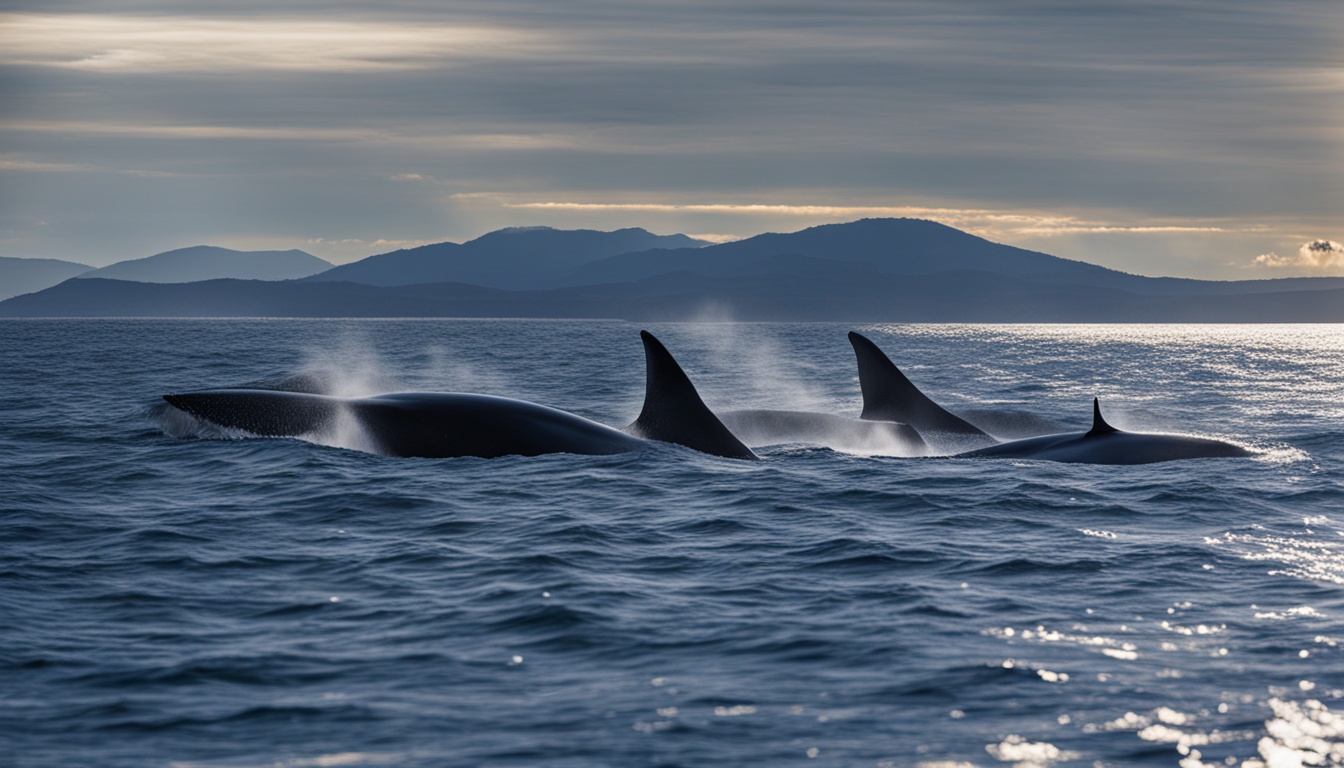Blue whales, the biggest animals on Earth, have a unique way of talking to each other. They use sound because the ocean is dark and vast, making it hard to see. These huge creatures make low-frequency calls and complex songs that can go for thousands of kilometers underwater.
This way of communicating helps them stay connected and find their way in the ocean. It’s key to their social life and survival. By studying how they communicate, we learn more about their behavior, how they find mates, and how they interact with other sea creatures.
The Role of Sound in Underwater Communication
In the deep sea, sound is key for communication among cetaceans, like the huge blue whale. Sound travels well in water, unlike light which fades quickly with depth. It lets whales sense changes in their environment that they couldn’t feel or see. This skill is crucial for their survival and how they interact with each other.
Cetaceans have special hearing tools that help them use sound a lot for who they are and where they are. Things like the melon in toothed whales help make and hear complex sounds. This shows how important sound is for cetaceans to talk to each other in their big ocean home.
Sound helps cetaceans not just find food and navigate but also keeps their social ties strong. They use special sounds to share feelings and work together, which is key for their groups. This shows us how complex their social lives are.
| Aspect | Details |
|---|---|
| Speed of Sound in Water | Approximately 1,500 meters per second |
| Visibility in Depth | Light diminishes rapidly, limiting visual communication |
| Acoustic Adaptations | Specialized structures enhance sound production and reception |
| Functions of Sound | Navigation, foraging, social interaction |
| Importance of Vocalizations | Conveys emotional states and fosters social bonds |
How do blue whales communicate?
Blue whales use sound to talk to each other in the ocean. This is key for their survival and social life. They have special ways to send messages through sound because the ocean is a tough place for communication.
Understanding Sound Transmission in Water
Sound travels differently in water than in air. It goes much farther because water is denser. Blue whales use very low sounds, like 14 Hz, to talk to each other. These sounds help them stay connected over long distances.
This special way of communicating is crucial for their social life. It helps them stay together and move as a group.
The Importance of Sound Density in the Ocean
The ocean’s density helps sound waves spread out. This is important for blue whales. Their sounds can travel far, letting them share important info with each other.
This shows how sound is key to their language. It helps them talk about things like where they are and how they’re doing. The way blue whales use sound shows how well they adapt to their ocean home.
Types of Blue Whale Vocalizations
Blue whales make a wide range of sounds that are key to their communication and social life. These sounds include low-frequency calls and songs. Each has its own pattern and purpose, making up what scientists call whale language.
Low-Frequency Calls and Their Purpose
Blue whales use low-frequency calls for important tasks like finding a mate and navigating. These calls can travel far, helping whales talk to each other over huge distances. Making these sounds is crucial for staying connected and talking within and between groups.
Distinct Songs and Their Patterns
Blue whales have about thirteen different song patterns, changing with the seasons. These songs can last up to 30 minutes and help whales stick together. They also let whales know who they are, helping them recognize each other in their pod. Studying these sounds deepens our understanding of whale language and their social lives.
| Type of Vocalization | Purpose | Duration | Context |
|---|---|---|---|
| Low-frequency calls | Navigation & Mating | Varies | Long-distance communication |
| Distinct songs | Social bonding | Up to 30 minutes | Seasonal behaviors (feeding, migrating) |
Blue Whale Behavior During Communication
Blue whales show complex social behaviors, especially in how they communicate underwater. Each group has its own way of talking, showing their identity and interactions.
Vocal Interaction Among Pods
Studies show that blue whales talk a lot when they are together in groups. They use special calls and songs to chat, much like different languages among humans. These sounds help keep the group together and let whales know who’s who in the sea.
This way of talking also helps whales feel connected and close to each other. It’s like having a secret language that only they understand.
Non-Verbal Communication Techniques
Blue whales don’t just talk; they also use body language and surface actions to communicate. Things like slapping their tails or jumping out of the water can mean different things. These actions might warn others of danger or show who’s in charge.
Learning about these silent ways of communicating helps us understand how blue whales live and interact with each other in the ocean.

Cetacean Communication: The Big Picture
Cetaceans have a complex way of communicating underwater. They use different methods to talk to each other in the sea. This shows how adaptable and smart they are. It’s interesting to see how blue whales and dolphins communicate in their own ways.
Comparative Analysis with Other Marine Mammals
Cetaceans make sounds to share information, but each species has its own style. Dolphins use clicks and whistles for echolocation. Blue whales make low sounds that can travel far. These differences show how their communication changes based on where they live and how they evolved.
| Species | Type of Communication | Primary Frequency Range |
|---|---|---|
| Blue Whale | Low-Frequency Calls | 10-40 Hz |
| Dolphin | High-Frequency Clicks and Whistles | 1-150 kHz |
| Orca | Complex Dialects | 0.5-20 kHz |
The Evolution of Acoustic Communication in Cetaceans
Over time, cetaceans got better at making sounds to talk to each other. They needed to communicate over long distances in the ocean. So, they learned to use low sounds that could travel far. This helped them in many ways, like finding food and staying together in the deep sea.
The Deep Sound Channel: A Unique Acoustic Environment
The deep sound channel, also known as the SOFAR channel, is key for blue whales to talk to each other underwater. It lets sound waves travel really far with little loss of strength. This means blue whales can talk to each other over huge distances, which is vital for their social life.
How Sound Travels Further in the Ocean
Sound moves faster and goes farther in water because it’s denser than air. The SOFAR channel is like a tunnel for sound, keeping it in place for long distances. This helps blue whales stay connected with their friends and family, which is important for their social life.
Using the Deep Sound Channel for Navigation
The deep sound channel also helps blue whales find their way around the ocean. They use sound to know where they are and where to find food. This shows how important sound is for their survival and how they’ve adapted to life underwater.
FAQ
How do blue whales communicate with each other?
Blue whales use low-frequency calls and complex songs to talk to each other. These sounds can travel far underwater. They help with mating, finding their way, and staying together.
What kinds of vocalizations do blue whales make?
They make low-frequency calls and songs that can last up to 30 minutes. There are about thirteen different song patterns. These change with the seasons.
Why is sound so important for blue whale communication?
In the deep ocean, it’s hard to see, so sound is key for blue whales. Sounds travel well in water. This lets them talk and sense their surroundings over long distances.
How do blue whales’ vocalizations differ from other marine mammals?
Unlike dolphins, which use high-frequency clicks and whistles, blue whales make low-frequency sounds. This shows they have special ways to communicate in the deep sea.
What role does the deep sound channel play in blue whale communication?
The deep sound channel helps blue whale sounds travel far without getting lost. It’s key for their navigation and talking to each other across the ocean.
How do blue whales use non-verbal communication?
They also use body language, like tail slapping and surfacing, to talk. These actions warn others or show who’s in charge in the group.
What insights can be gained from studying blue whale communication?
Learning how blue whales communicate helps us understand their social lives, mating habits, and how they interact with other sea creatures. It also deepens our knowledge of marine life.







